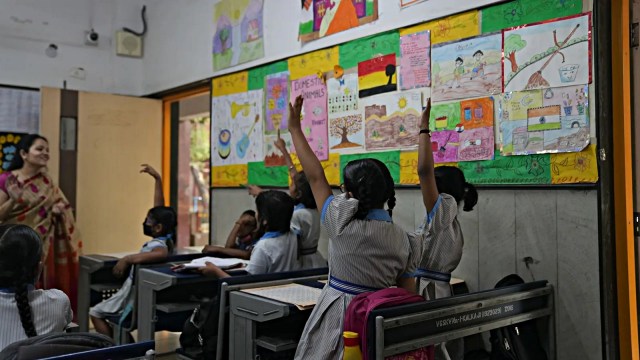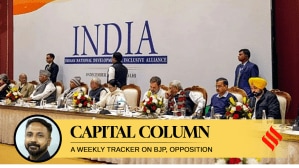Of borders and bright futures: Why children from UP villages along borders are thronging Delhi government schools
Accompanied by their mothers, school bags flung on their shoulders, these little residents of Ghaziabad and Noida villages troop into Delhi government-run schools day after day in the hope of “quality education”.
 Most of these Delhi government schools are located in border areas like Khichripur, New Kondli, Mayur Vihar Phase III, Vasundhara Enclave, Dallupura, Indraprastha Extension and Anand Vihar.
(Source: File)
Most of these Delhi government schools are located in border areas like Khichripur, New Kondli, Mayur Vihar Phase III, Vasundhara Enclave, Dallupura, Indraprastha Extension and Anand Vihar.
(Source: File)In a neighbourhood located at the foothills of a garbage mountain in Delhi’s Ghazipur, its residents keep hoping for a better life. But for hundreds of people, especially mothers, living in Uttar Pradesh (UP) villages alongside Delhi’s border, their children’s future looks brighter across the invisible divide between the two states.
Accompanied by their mothers, school bags flung on their shoulders, these little residents of Ghaziabad and Noida villages troop into Delhi government-run schools day after day in the hope of “quality education”.
Most of these Delhi government schools are located in border areas like Khichripur, New Kondli, Mayur Vihar Phase III, Vasundhara Enclave, Dallupura, Indraprastha Extension and Anand Vihar.
An hour before the bell signals the end of school in Delhi’s Khichripur village, located in the shadows of the Ghazipur landfill, the wide road transforms into an informal waiting area. Despite the lack of shade, parents both sit and stand in wait for the school gates to open.
Squatting on the gravelly road with other waiting parents, a mother who lives in Ghaziabad’s Khoda village, 5 km away, complains, “It is so tiring — cooking, then coming here (to drop the child) and then going back… it’s a never-ending cycle.”
Preeti Singal, a Noida-based homemaker, is among another group of parents waiting to pick up their wards. “I was lucky to be able to enrol my elder son (a student of Class 6) in this Delhi government school. My younger son, who is in Class 2, could not get admission here. Since we cannot afford to send him to a private school in Noida, he stays at home,” she says.
Seema Khurana, former head, Sarvodaya Kanya Vidyalaya (SKV), JJ Colony, Khichripur village, says the number of students from UP is much higher in five-six (Delhi government) schools closer to the border than local students.
“The (Delhi government) schools in Anand Vihar get students from Ghaziabad. In New Kondli, Dallupura and New Ashok Nagar (schools), they mostly come from Noida,” she says, adding, “During my time, a few students from UP had given proxy addresses so they could attend my school.”
Dhanisha, a teacher at school, says they have more students from UP than the neighbourhood at present. “Of nearly 2,000 students in the school, over half live in Ghaziabad’s Khoda Colony.”
Nazrin, 53, is a homemaker who moved to Khoda colony from Delhi a few years ago. She says her four children study at a government school in east Delhi’s New Kondli, located around 4 km away. Tasked with taking the children to school daily, Nazrin says she first takes a bus or an e-rickshaw, followed by a short walk to the school.
“It was tough moving to Khoda from Delhi. This area has very few schooling options after Class 5. So we decided to enrol all our four children in Delhi government schools. They are both affordable and good.”
Standing in a crowd of disgruntled mothers waiting to pick up their children, another homemaker is dismissive of promises made by political leaders. “These netas are all talk and no show. They simply don’t listen to ordinary citizens. It would have been helpful if we had schools in our neighbourhoods. Instead, we have to travel all the way to Delhi Ghaziabad to ensure our children have a future.”
Around 8 km away, 400 students are packed tightly in eight small rooms in a government school in Ghaziabad. A girl who studies in Class 8 at the Ghaziabad government school laments, “I wish I could study in a Delhi government school instead of this school.”
Despite the overcrowding, teachers say parents still try to enrol more children in the school. A primary school teacher says, “There aren’t many good options in the area after Class 8. Most boys from our school get admission in Delhi government schools after Class 8.”
Besides the lopsided student-teacher ratio in UP government schools along the Delhi border, the teacher says most of these schools have a dearth of subject-specific teachers and very limited infrastructure.
Adding to the list of reasons why parents prefer Delhi government schools, he says, “Parents prefer CBSE to UP board. Delhi government schools follow the CBSE syllabus and have much better facilities.”
Kanchan, 15, a student of Class 8 at a government school in Ghaziabad, is “worried” about her admission to a Delhi government school in Class 9. She says, “The quality of education in Delhi (government schools) is much better. Girls from the local inter-college keep telling me that Ghaziabad government schools have unruly students and that no learning takes place there.”
She says her father wants to get her admitted to a Delhi government school but is worried about her chances due to their Ghaziabad village address. “I need a Delhi address for a better chance at admission there.”
Former SKV, Khichripur head Khurana says though not everything is great in Delhi government schools, “they are far better” than those run by the UP government. “While Delhi government schools lack quality teachers, their educational standards are higher than those in UP government schools. Even the infrastructure is better in Delhi,” she says.
Over the last five years, according to Khurana, infrastructure in Delhi government schools has improved, even though issues like teacher vacancies and quality remain. “Many new teachers are not well-trained. When students come to government schools having poor teaching practices and teacher quality, that leads to a huge gap in learning. Most of these students are first-generation learners, but teachers simply cannot give them the individual attention they need to thrive,” she says.
Accusing these schools of “not using advanced technologies to teach”, she says, “Teachers focus on Class 10 and 12 board results rather than junior classes, where more focus is needed.”
Komal Kumari, 22, a former student of a co-ed Delhi government school in Dwarka who now takes tuition classes for children in Class 6 and 8 in her locality, agrees with Khurana.
“Despite efforts, there is a significant gap in foundational learning in Delhi government schools. I have seen Class 9 students struggle with basic reading and writing skills. Discrimination and partiality are also common issues there,” she says.
Crediting these schools for “positive” developments over the past decade, like increased opportunities for sports and extracurricular activities, she says, “Though infrastructure in Delhi government schools has improved, these upgrades are meaningless if the mindsets of and the methods used by teachers remain outdated. While private schools have successfully implemented hybrid learning, government schools have not yet replicated this model effectively.”
Meanwhile, not all parents living along Delhi’s borders are keen to send their children to government schools in the national capital.
Rajarani, 49, an anganwadi worker and a Khoda resident, says, “Crime hai Dilli mein, isliye badi beti ko regular mein nahi pada rahe (There is so much crime in Delhi that we did not send our elder daughter to a regular school). She finished her Class 10 from the School of Open Learning instead.”
Rajarani, who has lived in Khoda “for as long as she can remember”, says, “The law and order situation in UP is better than Delhi’s. We feel much safer here. In Delhi, people are used to freebies (a reference to free water and electricity for Delhi residents), which makes them reckless,” she claims.
Adding that nobody from her neighbourhood would send their children to Delhi if they had a choice, she says, “People are forced to admit their children to Delhi government schools out of sheer helplessness and nothing else.”












